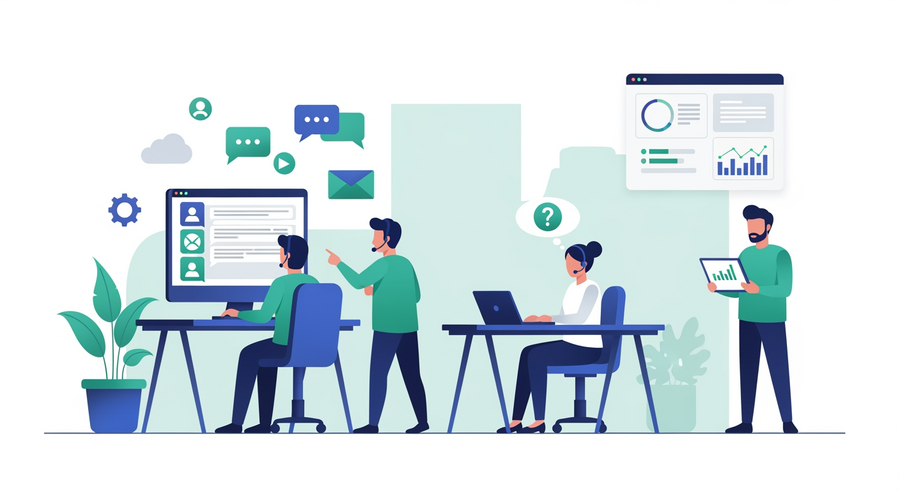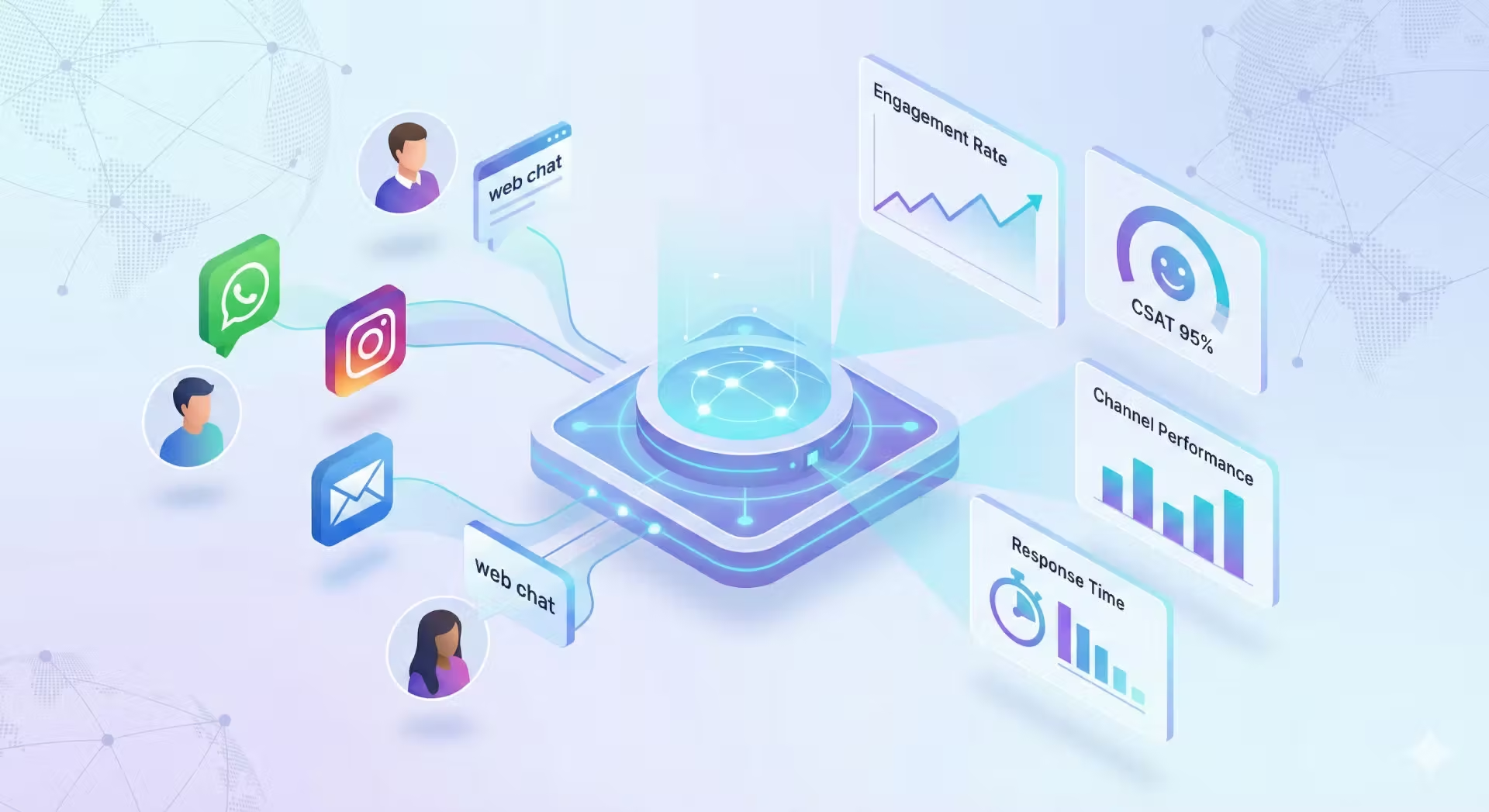Are you looking at your competitors and wondering how they manage to offer customer support around the clock without a hitch? The secret often lies in automation. Now, we're in the space of a wide range of automation tools. But today we want to zoom in on “automated bots”, from chatbots to task automation, and they can be used to help improve different aspects of your customer service.
In this blog, we will explore the world of automated bots. We will examine what they are, how they function, and the different ways you can incorporate them into your customer service strategy. We will also examine real-world examples of these bots and discuss their benefits and challenges.
Let's get started.
Why use automated bots?
Automated bots are more than another passing tech trend — they will transform how your business interacts with its customers, making interactions smoother and more efficient.
The global chatbot market was estimated at over $5 million in 2022 and is forecast to see a compound annual growth rate (CAGR) of 23.3% from 2023 to 2030. This rapid growth comes from the increased demand for 24/7 customer service, which your business is probably experiencing from its customers.
What is an automated bot?
An automated bot is a piece of software that performs tasks on behalf of users or other programs.
You can think of an automated bot like an assistant who never tires or loses their focus and can handle repetitive tasks at lightning speed. These bots can work on their own, following instructions they have been given to mimic human tasks. This could be tasks such as:
- Interacting with websites
- Chatting with visitors
- Rerouting people to the correct customer service desk
- Scanning through vast amounts of content
Types of bots
Automated bots can be considered an umbrella term, covering many different, specific types of bots.
Here are some examples of the most common types of automated bots.
- Chatbots: these are the friendly faces — or rather, interfaces — of your customer service automation. Powered by natural language processing (NLP), chatbots can understand and respond to customer queries in real time at any time of day. They give customers quick answers to common questions and pass them on to a human for more complex issues.
- Flowbots: Flowbots work like personal guides to help customers through various processes. Whether it's customer onboarding or troubleshooting, these automated bots lead your customers through a predefined workflow, ensuring they get consistent and accurate information.
- AI bots: AI automated bot uses artificial intelligence to perform tasks autonomously, often through machine learning and natural language processing. It can handle repetitive tasks, provide customer service, or perform data analysis with minimal human intervention.
- Task automation bots: these bots are designed to help increase your team's efficiency by automating various simple tasks. For example, a hotel or travel agency can use a task automation bot to handle bookings, manage schedules, and even route inquiries to the appropriate service desk.
- Voice bots: communicating through voice commands and responses, voice bots can reduce wait times and help your team handle more inquiries while maintaining a high level of customer service. They use advanced machine learning algorithms to understand and respond to spoken questions.
- Agent assist tools: by monitoring customer conversations, these automated bots recommend solutions and responses in real time. This can hugely cut down the time your team members spend searching for answers and improve the accuracy and quality of customer support.
How do automated bots work?
Automated bots use technology such as AI and NLP to perform tasks fast and accurately, often without human help. Here's how:
Bot technology
Machine learning, NLP, and AI are leading technologies behind automated bots.
- Machine learning allows bots to learn from data and improve over time, becoming more accurate in their responses.
- NLP helps bots understand and process human language, making interactions more conversational.
- AI enables bots to make data-driven decisions, recognise patterns, and handle complex tasks autonomously.
Functionality
Automated bots function by processing information and interacting with customers or other systems through a series of well-defined steps.
When a person sends a message, the bot uses NLP to interpret the text and understand the context of the message. It then retrieves the relevant information or performs the necessary action based on pre-programmed instructions or learned behaviour, such as connecting that person with a specific help desk.
For example, in automated customer support, a chatbot can understand a customer's request, such as changing a flight seat, by recognising key phrases and words. It then prompts the person for additional details, like the ticket number, and completes the task by interacting with the airline's booking system. This interaction is smooth and efficient, providing instant support to the customer while reducing the workload on your team members.
Market impact
According to a study on chatbot impact, 45% of customers now prefer chatbots as their primary mode of communication for customer service.
The top sectors benefiting from chatbots include:
- Real Estate: 28%
- Travel: 16%
- Education: 14%
- Healthcare: 10%
- Finance: 5%
This growing preference highlights how effective conversational AI, specifically chatbots, has become in various industries. Automated bots improve customer engagement and operational efficiency by providing fast responses and helping customers find solutions on the channels they want to use.
What is an example of an automated bot?
Automated bots are used in many industries to streamline customer service operations and improve customer experiences. Let’s examine some real-world scenarios.
1. Customer service Flowbots
Flowbots automate routine interactions and guide users through predefined workflows. For instance, a customer service Flowbot at a hotel can handle booking inquiries. When a guest wants to make a reservation, the Flowbot can ask for travel dates, room preferences, and payment information, ensuring a seamless and efficient booking process.
This reduces the workload on your customer service department and provides immediate service to customers, even outside service hours.
2. Virtual assistants
Virtual assistants like Siri, Alexa, and Google Assistant are prime examples of AI-driven bots that have become integral to our daily lives. These assistants can
- Set reminders
- Answer questions
- Play music
- Control smart home devices
Using NLP, they understand and respond to voice commands, making interactions natural and human-like.
3. Task automation bots
Task automation bots can be huge time savers in sectors like hospitality and travel. For example, a task automation bot in a hotel can manage services, from room service requests to booking confirmations and check-in procedures.
Similarly, in a travel Trengo customer, bots can handle flight bookings, itinerary changes, and customer inquiries. These bots operate in the background, performing repetitive tasks quickly, freeing up your staff to focus on more complex and personalised customer queries.
Industries that are making the best use of automated bots
Retail
Instacart, a grocery delivery startup uses automated bots to offer personalised search tools for its customers. Customers receive tailored suggestions and responses to open-ended inquiries like "What should I pack in my child's lunchbox?" or "Are there any gluten-free snacks?"
These responses include food preparation tips, product features, and dietary considerations, making customer interactions more personalized and human and encouraging the discovery of new products.
Restaurants
Wendy’s partnered with Google Cloud to create a fully automated drive-thru service. This AI handles customer orders and can even accommodate special requests like "no cheese" or "extra sauce."
Healthcare
Biofourmis uses AI for remote patient monitoring. The AI collects real-time physiological data from wearables, giving healthcare providers alerts and insights about abnormal patterns that could indicate potential health risks. This proactive approach helps in early detection and management of health issues.
Can a bot use AI?
AI is the simulation of human intelligence processes by machines. This is typically done by a computer system, and includes learning, reasoning, and self-correction.
Relationship between bots and AI
Bots and AI can work very well together. Bots are software applications designed to perform specific tasks automatically. They often use AI technologies, such as machine learning and NLP, to understand and interact with users in a more human-like way. However, while AI is the broader concept encompassing various forms of machine intelligence, bots are specific implementations that use AI to function how they are designed.
Benefits of automated bots
Automated bots can bring many great benefits to your business that enhance customer service and operational efficiency. Let’s take a look at how.
1. Efficiency
By automating routine tasks and providing immediate responses, bots help organisations meet customer expectations for speed and availability. With 83% of customers expecting immediate engagement, bots can handle an unlimited number of inquiries simultaneously, ensuring quick and accurate support.
2. Cost-effectiveness
Automated customer service can save you a lot of money. For instance, the healthcare, banking, and retail sectors are projected to save $11 billion annually through chatbot adoption. By handling large volumes of queries, bots enable you to increase your support capacity without hiring additional staff, and happy customers are more likely to return and purchase from your brand again.
3. 24/7 availability
Today’s customers demand round-the-clock support, which can be challenging and expensive to provide. Bots offer a cost-effective solution by providing 24/7 availability without needing more staff. This constant availability is highly valued by customers, with 64% citing 24-hour service as the best feature of chatbots. When a bot cannot resolve an issue, it can take a message so a team member can respond when they return to their desk.
4. Scalability
As your businesses grow, the volume of customer inquiries often increases. Bots can help you to scale customer support operations while retaining the level of customer care. They ensure consistent responses to common questions and allow you to manage increased volumes of queries without significantly expanding your staff.
Challenges and limitations
While automated bots offer a ton of benefits, gaining user acceptance and trust can be a challenge. Many customers remain hesitant to interact with bots and want to talk with humans. This comes from a lack of trust in the accuracy and reliability of bots and privacy concerns, with 63% of consumers worried about privacy and data security when using bots.
To increase acceptance in your customer base you can focus on transparency about how bots work and what data they collect. A hybrid approach, combining bots with human customer service staff for more complex queries, can give the best of both worlds to your customers.
Educating users about the benefits and functionalities of bots can also be helpful. Resources and training can help your customers understand how bots can be used to their advantage, such as not having to wait for a human to review and respond to a support ticket.
6 future automated bots
The future of automated bots promises transformative advancements across various industries.
Hyper-personalisation
Bots will use customer data to offer tailored experiences. For instance, retail bots can now analyse past purchases to recommend products, enhancing the shopping experience.
Voice-activated bots
Voice technology will lead to more voice-activated bots. In the automotive industry, these bots will assist with navigation, control in-car systems, and perform diagnostics.
Emotional intelligence
Bots will develop emotional intelligence, detecting and responding to customer emotions. This will make customer service bots more empathetic and effective.
Industry-specific solutions
Bots will cater to specific industries. In healthcare, for example, they will manage appointments, provide medication reminders, and offer preliminary diagnostics.
Real-time language translation
Bots will offer real-time language translation, helping with international customer service.
Autonomous decision-making
Bots will make autonomous decisions using real-time data. In logistics, they could optimise delivery routes based on traffic and delivery priorities.
Save time and money by automating your customer service
Automated bots are changing how all types of industries approach customer service. They offer a way to save your team time, make responses more efficient, and reduce costs.
Ready to start automating your customer service? Why not take a look at Trengo? Its platform helps you improve and personalise your customer service experience across all channels. With Trengo, you get chatbots, custom and native integrations, Flowbots, knowledge base management, a dashboard — and so much more.




.png)











